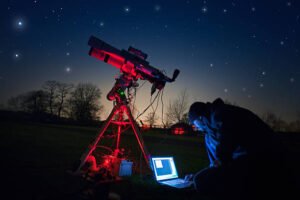Introduction to cosmos
![]()
In the vast expanse of the cosmos, our understanding of the universe is continually shaped by the lenses through which we observe it. As we celebrate the one-year anniversary of our journey into the blogosphere, let’s embark on a celestial voyage into the future of space exploration. In this cosmic adventure, we’ll unravel the mysteries and marvels that lie ahead with the next generation of space telescopes and observatories.
Unveiling the Future:
1. James Webb Space Telescope (JWST): A Glimpse Beyond Hubble
![]()
As the successor to the iconic Hubble Space Telescope, the James Webb Space Telescope (JWST) is poised to revolutionize our view of the cosmos. Delve into its advanced technologies, unparalleled capabilities, and the breathtaking images it promises to capture. From probing the atmospheres of distant exoplanets to peering into the early moments of the universe, the JWST is set to rewrite the cosmic narrative.
2. WFIRST: Widening Our Cosmic Vision
![]()
The Wide Field Infrared Survey Telescope (WFIRST) is next in line, expanding our cosmic vista with a focus on dark energy, exoplanets, and the mysteries of the universe. Explore how WFIRST’s cutting-edge instruments will enhance our understanding of the accelerating expansion of the cosmos and uncover the secrets hidden in the depths of space.
3. The European Extremely Large Telescope (E-ELT): A Giant on Earth, Eyes in the Sky

Set atop the Cerro Armazones mountain in Chile, the European Extremely Large Telescope (E-ELT) is not only a colossal engineering feat but also a game-changer in ground-based astronomy. Uncover how its colossal mirror and advanced instrumentation will enable unprecedented observations, capturing the faintest signals from the farthest reaches of the universe.
4. Nancy Grace Roman Space Telescope: Probing the Dark Side
![]()
Dive into the realms of dark energy, dark matter, and exoplanets with the Nancy Grace Roman Space Telescope. Named after the “Mother of Hubble,” this space observatory promises to unveil cosmic mysteries that have eluded our understanding for decades. Learn how its wide-field capabilities will transform our perception of the dark side of the universe.
The Collaborative Cosmos:
Explore the collaborative efforts of international space agencies, including NASA, ESA, and others, in bringing these extraordinary telescopes to life. Highlight the shared vision of unraveling the mysteries of the universe and how these collaborations amplify the scientific impact of each mission.
Conclusion:
As we celebrate one year of cosmic exploration in the blogosphere, the future of space telescopes and observatories beckons with promise and excitement. These incredible instruments are not just windows to the stars; they are gateways to new realms of knowledge, inspiring generations to come. As we gaze toward the heavens, let’s embrace the infinite possibilities that lie ahead in our quest to understand the cosmos. Join us on this celestial journey, where the stars are our waypoints, and the mysteries of the universe await their revelation.